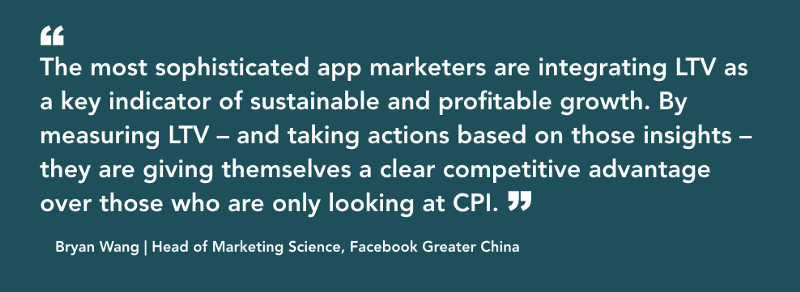
Marketing Has Evolved. Has Your Business Evolved With It?
If you’re not measuring return on marketing investment, your business is at risk.
If you’re not measuring return on marketing investment, your business is at risk.
Marketing is at the edge of a data analytics revolution. Leading companies are spending 25% or more of their annual revenue on marketing — even those that are spending less, are still spending significant amounts — and the C-Suite has developed a thirst for hard (and accurate) numbers to measure that spend AND its impact on their business.
It makes sense then that we agree — not just CEOs or CFOs, but CMOs too — that marketing is an investment. We want to measure returns, not just costs. We want to understand and act on revenue and customer lifetime value.

The most sophisticated marketers may be using meaningful return on marketing investment metrics like LTV and retention, but the majority of marketers are not. They’re still using proxy metrics. These companies are stuck using non-ROI KPIs like cost minimization, reach, and engagement, and are most likely paying the price for it.
Even for those marketers that are using improved metrics, actually delivering a return on marketing investment isn’t guaranteed. It not only requires an accurate assessment of marketing costs, but also an assessment of revenue in the form of customers’ lifetime values, which includes a combination of payer conversion, payer revenue, ad revenue, conversion, customer virality, and more depending on the business.
I’ve spent my career analyzing these metrics, building data models, and fighting for companies to view marketing as an investment. It’s never been a more important time for companies to understand this — decreasing margins, increasing competition, in-housing, ad fraud, etc, all put businesses at risk. That’s why I’ve decided to share my thoughts on some of the challenges that companies and marketing teams face — links included so you can jump directly to any section.
Calculating Customer LTV is Incredibly Tricky
To effectively build a bespoke LTV-model for a single company requires a heavy engineering lift of, on average, six or more months of dedicated development time, which can easily add up to hundreds of thousands of dollars of investment not to mention time spent. That team will need to unify disparate tech stacks, collect and import extensive data history, develop and refine a bespoke model, then validate that model, and finally deploy that data in a usable way for companies to improve their marketing investment. So, it’s no surprise that 58% of marketing leaders have moderate or no trust in their LTV modeling. Or that only 25% are confident they can quantify ROI.
In lieu of an effective ROI calculation, marketing departments accept non-ROI metrics that are easier to come by. They’re so easy to come by, in fact, they’re readily provided to marketers by the very marketing platforms who benefit directly from marketing spend. It’s no coincidence that the KPIs that drive the platform’s growth are the very ones so beautifully presented on their dashboards.
In my experience there are three types of proxy goals we use to “measure” performance: cost minimization (e.g. lower CPM, lower CPI, lower CAC), volume delivery (maximizing reach, installs, engagement, etc.) and short-term goals that can verge on random (a certain amount of revenue in a certain number of days, a benchmark conversion rate, or driving a specific engagement).
The False Metrics of Marketing “Success”

Cost Minimization: Cheaper ≠ Better
In the era of lean, it’s no surprise marketing departments are swayed by the opportunity to deliver cost savings. The thinking goes: if it costs less, we must be getting better value. Unfortunately, costs to acquire new users are rising and the margins from those customers are shrinking. Even if cost minimization were the true business goal (it’s not; the true business goal is profit) — it’s a hard target to sustain.
Volume Delivery: More ≠ Better
A volume delivery metric comes directly from the sales floor — if we’re reaching more people who are installing, that’s good for business, right? However, the equation remains incomplete. If companies reach the wrong people (low to no LTV customers), they’re paying for people they don’t want. In actuality, this metric aligns perfectly with the sales goals of the marketing platforms. To maximize reach, increase installs, or encourage engagement you simply need to buy more ads. Since platforms love more spend (by the way, more spend means a healthier, more competitive auction, which also means rising costs) and many vendors charge companies a percentage of ad spend, any spend — regardless of its effectiveness — this is good business for platforms and vendors…but maybe not the companies relying on them.
Short-Term Goals: Immediate ≠ Better
Finally, in the quest for some kind of analytic goal setting, many companies and marketing teams create short-term goals that sound and look like real goals, but quickly dissolve under further investigation. These short-term goals are meant to act as an immediate proxy for longer-term success — getting a customer to buy today may increase the odds someone spends more long-term, but it certainly does not guarantee that outcome. These types of campaigns may hit their short-term goals (why not focus on the long-term goal from the outset?), but overall they miss the point.
To be blunt, the real danger is that your company may be running an elaborate way to spend money. Short-term metrics may be applauding the business all the way to its downfall. At best, these proxy KPIs are incomplete and the marketing is effective. At worst, the marketing appears successful and is not. The misalignment of marketing success metrics and company success metrics can mean that ad spend is optimized for short-term “success” not long-term success.
Marketing Is an Investment
As obvious as it might seem, it’s a business imperative to flip the view of the marketing department from cost center to investment hub. The business must look at returns, not just costs, and marketing should not get a free pass simply because it’s historically been viewed as a soft science. This may have been true 5+ years ago when marketing and customer acquisition costs were more easily arbitraged — digital was new, platforms were new, so the earliest and smartest marketing teams were able to extract incredible value. Those days are gone. Acquisition costs have been on the rise, margins have become tighter, and extracting incremental value has become increasingly more difficult. A business’ only defense to combat these trends, if they intend to survive for the long-term, is to be smarter about their marketing investment.
It’s time for marketing to embrace its role as the investment engine of the company. We’re in the midst of an analytical revolution where marketing can arm itself and their companies with the data and analytics that are now available, and use that as the catalyst to drive real business value.
This is why we built AlgoLift.








